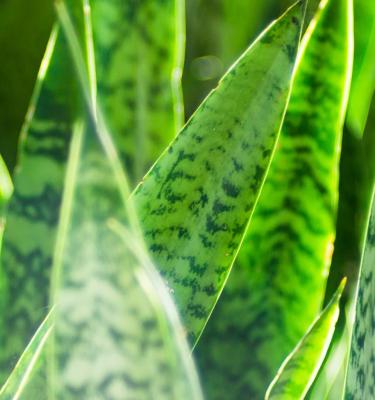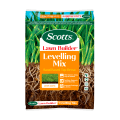

How to Grow and Care for Snake Plants in Australia
Snake Plants are the easiest houseplant of all to grow. This undemanding plant will grow in the most challenging of conditions and make a striking statement no matter what!
It’s a great all-rounder – low maintenance, an air purifier, and attractive. Although snake plants don't need much care, there are some things you can do to help them thrive in your home.
Top three steps to grow Snake Plants
Snake Plants can be identified by their dark green leaves with grey or pale green horizontal stripes. These leaves can be up to 2m (6’) in height, although they are usually much shorter when the roots are confined to a pot.
This evergreen perennial can be grown in the garden in tropical areas of northern and eastern Australia, but it can become a stubborn weed, so we prefer to recommend it as a houseplant.
The most important steps to remember when growing Snake Plants are:
- Do not over water them
- Keep them out of reach of pets and children (as they are poisonous)
- Plant into a slightly sandy potting mix which is specially formulated for houseplants
Particular cultivars of Snake Plants which we like include:
- Dracaena trifasciata ‘Black Coral’. Very dark green leaves with grey horizontal stripes.
- Dracaena trifasciata ‘Black Dragon’. A compact cultivar with minimal variegation on the leaves.
- Dracaena trifasciata ‘Golden Flame’. Notable for its bold yellow leaf edges.
- Dracaena trifasciata ‘Hahnii’, also known as Bird’s nest snake plant. Small and stumpy but no less beautiful than other cultivars, this one reaches only about 20cm (6-7”) in height.
- Dracaena trifasciata ‘Laurentii’. A popular cultivar which reaches 60cm (24”) tall, even when confined to a container.
- Dracaena trifasciata ‘Metallica’. Mid green leaves, with silver horizontal stripes.
- Dracaena trifasciata ‘Moonshine’. Light green leaves with dark green leaf margins.
All of these cultivars and Snake Plant varieties will do a great job of purifying the air, removing unwanted toxins and pollutants from the atmosphere – all the best Snake Plant benefits!
A related species, Dracaena cylindrica, or African spear, is often referred to as a Snake Plant. This species has attractive cylindrical leaves. It needs more regular watering than Dracaena trifasciata.
Plant and Place
The Perfect Potting Mix for Snake Plants
Snake Plants need a potting mix which is slightly sandy and well-drained. We recommend Scotts Osmocote Cacti & Succulent Potting Mix. This particular potting mix will provide a steady supply of nutrients to the Snake Plant, and is at the right consistency to allow air and moisture to flow around the roots.
Snake Plants are best propagated by dividing an existing plant. For Snake Plant propagation you should:
- Loosely fill a small pot with a potting mix as detailed above
- Remove the existing plant from pot
- Use a sharp knife to remove a leaf and part of the root
- Make a hole in the middle of the potting mix, and place the plant in the pot so that the top of the rootball is slightly below the top of the container.
- Add more potting mix to cover the top of the rootball, and around the sides if needed so that the plant is sitting snuggly in the new container.
- Water well and leave to establish.
Light
Although they’re not fussy, ideally provide a bright spot away from direct sunlight for your Snake Plant. Snake Plants will tolerate a considerable amount of shade, although the interesting variegation can disappear without enough light.
Wipe the leaves occasionally to remove dust and help light to reach the leaves.
How to Care for and nurture your Snake Plants
Watering Snake Plants
Water fortnightly, reducing this to monthly during the winter. It’s essential for Snake Plant care to allow the potting mix to dry out before watering, and never allow the plant to sit in water.
Temperature & Humidity
Snake Plants prefer a temperature of 10°C or higher. However, they are almost indestructible, and only consistently cold temperatures will threaten it.
A drier atmosphere will suit a Snake Plant best, although it will tolerate some humidity.
Feeding Snake Plants
Feed monthly, apart from in the winter, by applying Scotts Osmocote Pour+Feed for Indoor Plants.
How to repot Snake Plants
Snake Plants should be repotted when their roots start to push through the bottom of the pot. This won’t be very frequently as the plants grow very slowly. It's the perfect opportunity to produce some more plants. Always wear gloves when handling Snake Plants, as they are poisonous:
- Choose a slightly larger pot than the one already being used
- Spread a thin layer of suitable potting mix across the bottom of the pot.
- Gently spread the roots of the Snake Plant.
- Place the plant in the centre of pot, so that the top of the rootball is slightly below the lip of the new container, and then add more potting mix to ensure good contact between the roots and potting mmic.
- Water well and leave to establish.
Common pests and diseases with Snake Plants
Snake Plants are susceptible to many of the same pests and diseases that other houseplants suffer from.
- Why are the leaves of my Snake Plant going yellow and/or soggy?
Over watering can cause root rot. Only water your Snake Plant when it is dry, and don’t allow the bottom of the pot to stand in water.
- Why does my Snake Plant have furry white patches on the leaves?
Mealybugs cause unsightly patches on leaves - wipe away, and then spray with an insecticide, such as Defender™ Pyrethrum Insect Spray.
- Why does my Snake Plant have webbing on the leaves?
Spider mites can cause this unsightliness. Wipe away webbing and the tiny mites, and improve air circulation.
- Why are the leaves of my Snake Plant turning wrinkly?
Underwatering can cause the leaves to shrivel slightly. Provide water each day until the leaves return to normal.
- Why are the leaves of my Snake Plant wilting and turning dark brown?
Southern blight can affect Snake Plants, killing them very quickly if untreated. Apply a fungicide, improve air circulation around the plant, and do not re-use pots which have been affected by it.
- What are the brown and red spots on the leaves of my Snake Plant?
Red leaf spot can cause unsightly spots on the leaves. Improve air circulation, remove and destroy affected foliage, spray with a fungicide.
- Why has my Snake Plant got notches along the edges of the leaves?
Adult vine weevils love potted plants, and will nibble the edges of the leaves, leaving bite marks where they have been. If untreated the adults will lay eggs, emerging as larvae which will attack the roots of the Snake Plant, potentially killing it. Remove and destroy weevils and larvae, and apply an insecticide if the symptoms continue.
FAQs
What is a snake plant?
Tough, stylish, and practically unkillable – that’s the snake plant (Dracaena trifasciata, formerly Sansevieria). With its upright, sword-like leaves, it brings a modern edge to any space. It’s happy in low light to bright indirect light, thrives on a little neglect, and even gives your indoor air a boost. While it’s often praised for filtering out nasties like formaldehyde and benzene, it’s not a replacement for fresh air – but hey, every little bit helps!
Mother-in-law's tongue vs snake plant
Same plant, different name! Mother-in-law’s tongue and snake plant both refer to Dracaena trifasciata. The first name comes from its long, sharp leaves, while the second is inspired by its striped, slithery look. Whatever you call it, this hardy, air-purifying legend is one of the easiest plants to grow indoors in Australia.
What other names does a snake plant go by?
The snake plant has a few aliases up its sleeve! You might hear it called "Mother-in-law’s tongue," "Saint George’s sword," or "Viper’s bowstring hemp" – all thanks to its tough, upright leaves. Some people also call it a "sword plant", but whatever the name, it’s a low-maintenance indoor champion.



